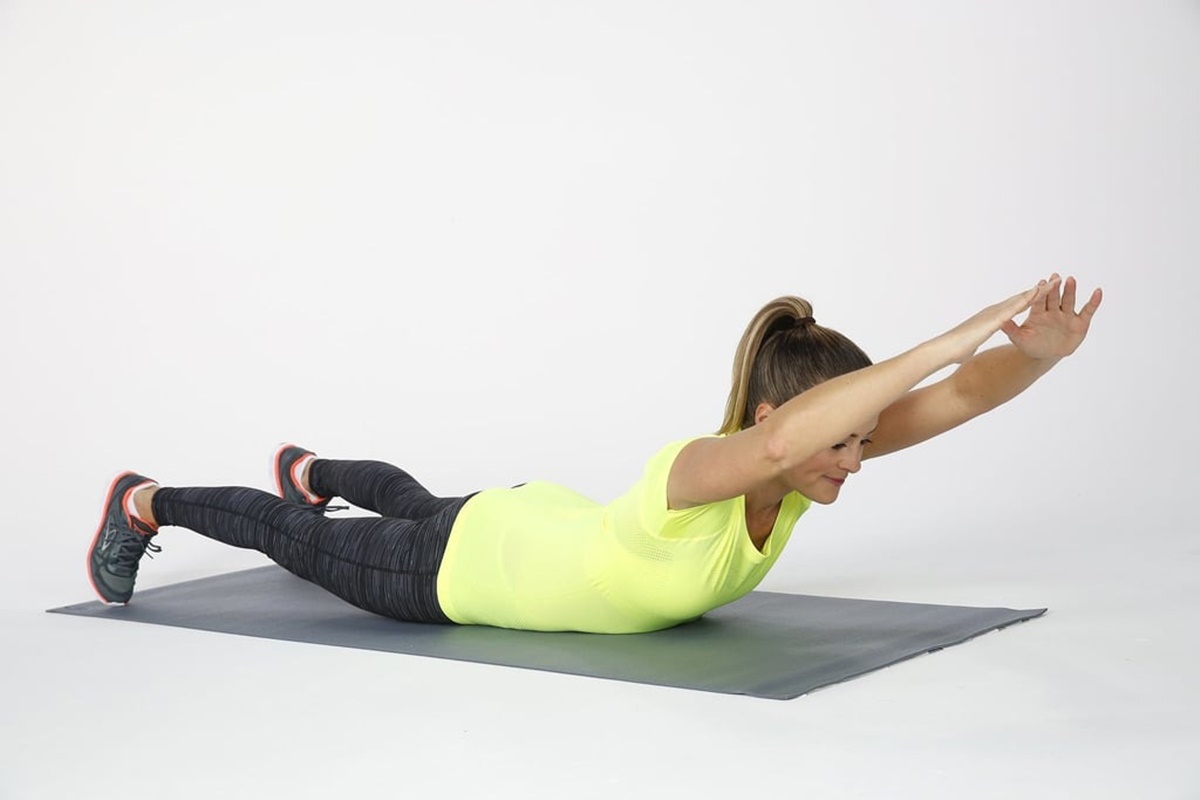

Featured
How To Exercise Your Neck
Modified: January 2, 2024
Learn how to strengthen and tone your neck muscles with featured exercises. Improve posture and reduce tension with our expert tips and techniques.
Introduction
Our neck plays a crucial role in our overall well-being. It is responsible for supporting the weight of our head, allowing us to move it in various directions, and protecting the delicate spinal cord. However, due to prolonged periods of sitting, poor posture, or even stress, the muscles in our neck can become stiff and weak.
Exercising your neck can help alleviate muscle tension, improve flexibility, and strengthen the muscles that support the neck. In this article, we will explore the benefits of exercising your neck, warm-up exercises to prepare your neck for more intense movements, strengthening exercises to build neck muscles, stretching exercises to increase flexibility, as well as important tips to follow for a healthy neck during exercise.
By incorporating these exercises into your regular routine, you can not only minimize discomfort and pain but also enhance your overall range of motion, posture, and quality of life. So, let’s dive in and discover how to properly exercise your neck for a strong and resilient upper body!
Benefits of Exercising Your Neck
Regularly exercising your neck provides numerous benefits for both your physical and mental well-being. Here are some key advantages of incorporating neck exercises into your fitness routine:
- Improved Range of Motion: Neck exercises can enhance the flexibility and mobility of your neck, allowing you to move your head more freely in various directions.
- Reduced Muscle Tension: Many people experience stiffness and tension in the neck due to poor posture or long periods of sitting. Exercising your neck can help alleviate muscle tension, promoting relaxation and reducing discomfort.
- Enhanced Posture: Strong neck muscles contribute to better overall posture. By strengthening these muscles, you can reduce the likelihood of slouching and improve the alignment of your head and spine.
- Pain Relief: Neck pain is a common issue for many individuals. Engaging in targeted neck exercises can help alleviate pain and discomfort caused by muscle strain, tension headaches, or even conditions like cervical spondylosis.
- Injury Prevention: A strong neck can provide support and stability to the rest of your body, reducing the risk of injury during physical activities or accidents.
- Improved Blood Circulation: The gentle movements involved in neck exercises can stimulate blood flow to the neck muscles, providing them with essential nutrients and oxygen.
- Stress Relief: Exercising your neck can be a therapeutic activity that helps to release tension and stress. It promotes relaxation and can contribute to an overall sense of well-being.
These benefits highlight the importance of incorporating neck exercises into your regular fitness routine. Whether you are experiencing neck pain or simply looking to enhance your neck’s strength and flexibility, these exercises can make a significant difference in your overall neck health.
Warm-up Exercises for the Neck
Before diving into more intense neck exercises, it is crucial to properly warm up the muscles to prevent injury and maximize the benefits. The following warm-up exercises will help prepare your neck for movement:
- Neck Rotations: Sit or stand up straight with your shoulders relaxed. Slowly rotate your head in a circular motion, bringing your chin towards your chest, then to each shoulder, and finally back to the starting position. Repeat this movement 5-10 times in each direction.
- Neck Tilts: Start in the same upright position. Tilt your head towards one shoulder, bringing your ear closer to it without lifting your shoulder. Hold the stretch for a few seconds and then repeat on the other side. Perform 5-10 repetitions on each side.
- Neck Extension: Gently tilt your head back, keeping your chin parallel to the ground. Hold this position for a few seconds and then bring your head back to a neutral position. Repeat 5-10 times.
- Neck Flexion: Lower your chin towards your chest, feeling a gentle stretch in the back of your neck. Hold this position briefly before returning to the starting position. Repeat 5-10 times.
- Side-to-Side Head Movements: Start with your head in a neutral position. Slowly turn your head to one side, trying to bring your ear closer to your shoulder without lifting it. Hold for a few seconds and then repeat on the other side. Perform 5-10 repetitions on each side.
These warm-up exercises target the major muscles in your neck, preparing them for more intense movements. Remember to perform these exercises slowly and gently, avoiding any jerky or forceful motions. If you experience any pain or discomfort, stop the exercise and consult with a healthcare professional.
Now that our neck muscles are properly warmed up, we can move on to the strengthening exercises that will help build strength and stability in this important area of the body.
Strengthening Exercises for the Neck Muscles
Building strength in your neck muscles is crucial for maintaining proper posture, reducing the risk of injury, and improving overall neck health. Here are some effective strengthening exercises to incorporate into your routine:
- Neck Resistance Exercise: Sit or stand upright with your shoulders relaxed. Place one hand on the side of your head, gently press your head against your hand, and resist the force. Hold for a few seconds and then relax. Repeat this exercise on each side of your head, performing 8-10 reps on each side.
- Neck Isometric Exercise: Place your palm on your forehead and press your forehead into your palm, creating resistance. Hold this position for a few seconds and then release. Repeat this exercise with your palm on the back of your head and on each side, performing 8-10 reps for each direction.
- Prone Neck Extension: Lie face down with your forehead on the floor. Place your hands on the back of your neck. Lift your head slightly off the floor, engaging the muscles in the back of your neck, and hold for a few seconds. Slowly lower your head back down. Perform 8-10 repetitions.
- Chin Tucks: Stand or sit up straight with your shoulders relaxed. Gently tuck your chin in towards your chest, feeling a stretch in the back of your neck. Hold this position for a few seconds and then return to the starting position. Repeat 8-10 times.
- Resistance Band Exercise: Attach a resistance band to a sturdy anchor point (such as a door handle). Hold the other end of the band with your hand, resting your elbow on your thigh. Slowly pull the band towards your body, bringing your hand to your head while resisting the pull of the band. Repeat this exercise on each side, performing 8-10 reps on each side.
Remember to start with lighter resistance and gradually increase it as your strength improves. It is essential to maintain proper form throughout these exercises, focusing on controlled movements and avoiding any jerking or straining. If you experience any pain or discomfort, stop the exercise and consult with a healthcare professional.
Strengthening your neck muscles with these exercises will not only improve your posture and reduce the risk of injuries but also contribute to a strong and stable neck that can withstand the demands of daily activities.
Stretching Exercises for the Neck
Stretching is an essential part of any workout routine, as it helps increase flexibility, relieve tension, and promote better range of motion. Here are some effective stretching exercises specifically targeting the neck muscles:
- Neck Side Bend: Sit or stand up straight with your shoulders relaxed. Gently tilt your head to one side, bringing your ear closer to your shoulder without lifting it. You should feel a gentle stretch on the opposite side of your neck. Hold for 15-30 seconds and then repeat on the other side. Perform 2-3 repetitions on each side.
- Neck Rotation Stretch: Again, starting in an upright position, slowly turn your head to one side, trying to bring your chin over your shoulder. You should feel a gentle stretch in the back of your neck. Hold for 15-30 seconds and then repeat on the other side. Perform 2-3 repetitions on each side.
- Upper Trapezius Stretch: Sit or stand up straight with your shoulders relaxed. Tilt your head to one side and then gently place your hand on the opposite side of your head, applying slight pressure to increase the stretch. Hold for 15-30 seconds and then repeat on the other side. Perform 2-3 repetitions on each side.
- Chin to Chest Stretch: Lower your chin towards your chest, feeling a stretch in the back of your neck. Hold this position for 15-30 seconds and then return to the starting position. Perform 2-3 repetitions.
- Levator Scapulae Stretch: Sit or stand up straight with your shoulders relaxed. Gently rotate your head to one side and then tilt your chin slightly downwards. Place the hand on the same side of your head on the back of your neck and apply gentle pressure to increase the stretch. Hold for 15-30 seconds and then repeat on the other side. Perform 2-3 repetitions on each side.
When performing these stretches, remember to breathe deeply and relax into the stretch. Only stretch to the point of mild discomfort, never to the point of pain. If you experience any pain or discomfort, stop the stretch and consult with a healthcare professional.
Incorporating these stretching exercises into your routine will help improve the flexibility and mobility of your neck, allowing you to move more freely and comfortably throughout the day.
Tips for Maintaining a Healthy Neck During Exercise
While exercising your neck can bring numerous benefits, it is essential to prioritize safety and proper form to prevent any potential injuries. Here are some tips to help you maintain a healthy neck during exercise:
- Start Slowly: If you are new to neck exercises or have any pre-existing neck issues, start with gentle movements and gradually increase the intensity and duration over time.
- Focus on Proper Alignment: Maintain proper posture throughout the exercises by keeping your head aligned with your spine, avoiding excessive tilting or twisting.
- Listen to Your Body: Pay attention to any sensations or discomfort during the exercises. If you experience any pain, dizziness, or numbness, stop and consult with a healthcare professional.
- Avoid Jerky Movements: Perform all exercises with controlled and smooth movements, avoiding any sudden or forceful motions that may strain the neck muscles.
- Use Proper Equipment: If using resistance bands or other equipment, ensure they are in good condition and appropriate for your fitness level. Follow the instructions and guidelines provided by the manufacturer.
- Stay Hydrated: Drinking plenty of water throughout the day helps keep your muscles hydrated and may reduce muscle tension and stiffness.
- Take Breaks: If you engage in activities that require prolonged neck positions, such as computer work, take frequent breaks to stretch and rest your neck muscles.
- Seek Professional Guidance: Consult with a qualified healthcare professional, such as a physical therapist or exercise specialist, for personalized advice and guidance tailored to your specific needs and conditions.
Remember, everyone’s body is different, and what works for one person may not work for another. It is crucial to listen to your body and modify or stop any exercise that causes pain or discomfort. Your safety and well-being should always be the top priority.
By following these tips, you can ensure that your neck remains healthy, strong, and injury-free during your exercise routine.
Conclusion
Taking care of your neck through regular exercise is vital for maintaining a healthy and pain-free upper body. By incorporating warm-up exercises, strengthening exercises, and stretching exercises into your routine, you can improve flexibility, reduce muscle tension, and enhance the overall strength of your neck muscles.
Remember to always start with a proper warm-up to prepare your neck for exercise. Gradually increase the intensity and duration of your exercises, focusing on maintaining proper form and listening to your body. If you experience any pain or discomfort, stop the exercise and consult with a healthcare professional.
In addition to exercise, adopt good posture habits throughout your day-to-day activities. Be mindful of maintaining proper alignment of your head and spine, and take regular breaks to stretch and relieve any tension in your neck muscles.
It is important to note that every individual is unique, and it is essential to consult with a healthcare professional before starting any new exercise program, especially if you have pre-existing neck conditions or concerns.
By following these tips and consistently incorporating neck exercises into your routine, you can promote a strong, flexible, and pain-free neck. Prioritize your neck health and enjoy the benefits of a well-conditioned neck that supports your overall well-being.








